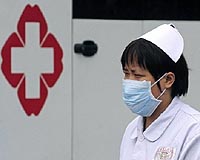| . |  |
. |
Paris (AFP) Aug 27, 2009 The swine flu is unlikely to become more virulent as it spreads through the northern hemisphere this winter, but could re-emerge a year later in a more deadly form, a top expert said Thursday. "We should get through the winter relatively easily, I don't think the virus will mutate before then," said John Oxford, a professor of virology at Britain's St Bartholomew's and the Royal London Hospital. "There will be more people in hospital and more deaths, but essentially it will be the same virus we have experienced in the summer, just more of it," he told AFP in an interview. After winter has passed, however, the pressures of natural selection could favour the emergence of more deadly strains of the A(H1N1) virus, Oxford explained. "For the moment, the virus is running around the world finding lots of young people and infecting them. It is doing very nicely, thank you, why should it change?", he said by phone. "But once the virus has infected about a third of the world's population -- which is what we expect -- it will find less 'susceptibles'. That is when mutants will have a selective advantage." It would be a serious mistake to think that once the impending flu season is over, the danger will have passed, he added. Oxford said he had just returned from Australia, where he met front-line doctors who were concerned about an emerging pattern in swine flu patients. Whether they are people in high risk groups -- the obese, pregnant women, asthmatics -- or young adults with no underlying conditions, an alarming number of patients wind up in intensive care units. "One minute they are OK in a hospital bed, the next minute they are in intensive care," he said. There have been more than 100 confirmed deaths from the pandemic H1N1 strain in Australia, which is just emerging from the southern hemisphere winter. Epidemiologists sifting through data from other countries have also found similar -- and disquieting -- patterns. French epidemiologist Antoine Flahault reported a 100-fold increase, compared to seasonal flu, in the number of swine flu deaths in Mauritius and New Caledonia attributed directly to the virus itself rather than secondary bacterial infections or underlying conditions. Many of those deaths were caused by acute respiratory disease syndrome (ARDS), which requires intensive-care treatment for an average of three weeks. Only 50 percent of ARDS patients survive.
earlier related report The toll puts it ahead of the latest count from the United States, which as of August 20 had 522 swine flu deaths, according to the US Centers for Disease Control and Prevention. Brazil's health ministry said in a statement the government was freeing up one billion dollars to buy 73 million doses of a new vaccine being developed against swine flu, as well as Tamiflu stocks, hospital equipment and diagnostic gear. It added that the infection rate appeared to be diminishing in the country, which is about to exit the southern hemisphere winter at the end of this month. The ministry stressed that, as a ratio of its population of 190 million, Brazil's mortality rate from the virus ranked 7th in the world. Argentina, Chile, Costa Rica, Uruguay, Australia and Paraguay all had higher rates on that basis, it said, referring to data from the European Center for Disease Prevention and Control. The United States, which has a population of 300 million, came 13th on the list. The Americas is the worst-hit region in the world in terms of swine flu deaths, accounting for more than 90 percent of the global count given by the World Health Organization. After Brazil and the United States, Argentina is the country to suffer the most, with at least 439 swine flu deaths. Share This Article With Planet Earth
Related Links Epidemics on Earth - Bird Flu, HIV/AIDS, Ebola
 Give flu vaccine to nurses, chronic sick first: EU experts
Give flu vaccine to nurses, chronic sick first: EU expertsBrussels (AFP) Aug 25, 2009 Pregnant women, health workers and people with underlying health problems should receive swine flu vaccines ahead of the rest of the population, EU experts recommended Tuesday. There was no call for children to be prioritised. A previous idea to include young people in the list of those to be vaccinated first "was abandoned", an EU source said, without giving a reason. "All persons ... read more |
|
| The content herein, unless otherwise known to be public domain, are Copyright 1995-2009 - SpaceDaily. AFP and UPI Wire Stories are copyright Agence France-Presse and United Press International. ESA Portal Reports are copyright European Space Agency. All NASA sourced material is public domain. Additional copyrights may apply in whole or part to other bona fide parties. Advertising does not imply endorsement,agreement or approval of any opinions, statements or information provided by SpaceDaily on any Web page published or hosted by SpaceDaily. Privacy Statement |